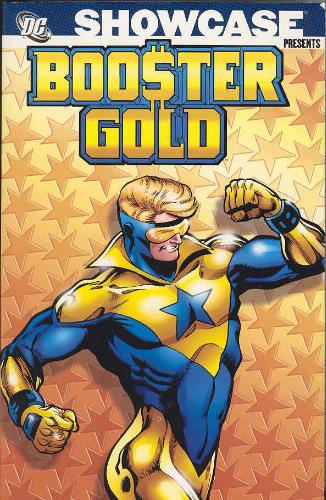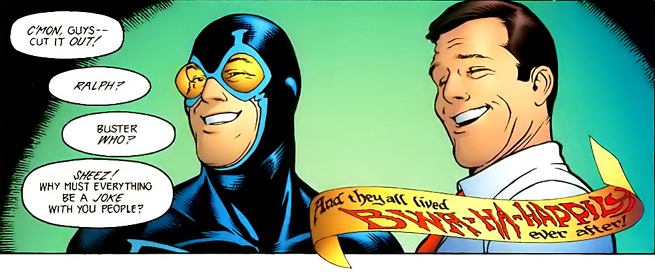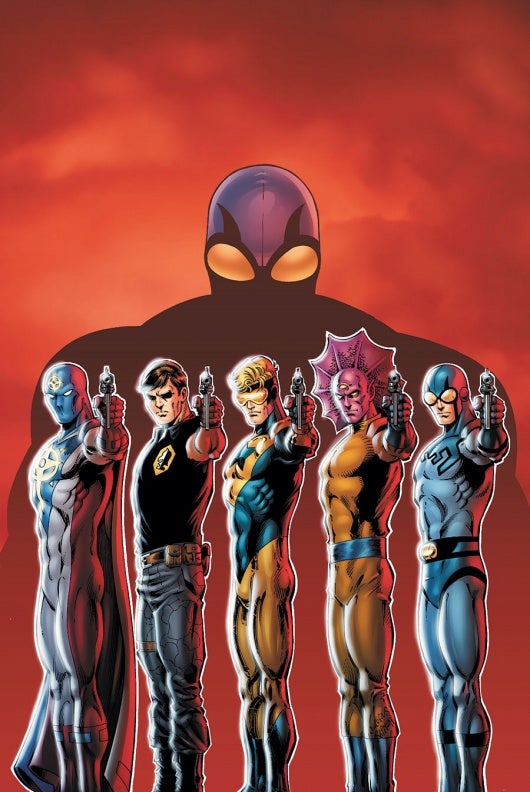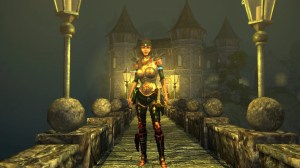
Videos by ComicBook.com
If you missed it, we talked at some length about the issue as well as Superman: Doomed #2 which seems to share a number of important properties with Booster Gold.
With Booster and his longtime pal Blue Beetle joining up with Justice League 3000 soon, and clearly playing a big role in the second half of The New 52: Futures End, we figured it’s a pretty good time to look at some of his most memorable adventures.
(And, yes, we’re playing it fast and loose with the top ten thing. Forgive us; we’re just counting certain “merged” entries as 1.5 instead of two.)

It’s rare to find full runs reprinted from the ’80s and ’90s, but not so long ago, DC Comics published a black-and-white paperback edition of the first volume of Booster’s series.
It’s interesting to see the book unfold in hindsight, especially becuase his now-well-known origin story didn’t come into play until the book had been running for a while. His first adventures didn’t reveal that he was a time-traveler at all, and even tried to hide the fact that he got his powers from his equipment.
It was a very different kind of book, almost procedural in its approach to the superhero genre. Yes, he fought supervillains fairly often, but they were almost always a secondary concern. He was running a business empire, tackling a group of villains who were very well-organized and run by a faceless leader they needed to identify in order to put a stop to his organization, and of course there was eventually the 25th Century law enforcement coming after him for unlawfully stealing a time machine (a death penalty offense for obvious reasons).
Incidentally, that particular plot beat would show back up years later when Keith Giffen and J.M. DeMatteis wrote Booster’s own series — although the recurring cop character from Booster Gold Volume 1 never showed up again after the series was cancelled.

While he’s considered a key part of the book’s success, Booster Gold didn’t actually appear in the first arc of Justice League for very long, coming in only at the very tail end and ultimatley being a bigger part once the series shifted its title to Justice League International and found its focus.
Now published in hardcover form as Justice League International Volume II by Giffen, DeMatteis and artist Kevin Maguire, Booster’s first full book of tales with the JLI was for a long time available as a softcover titled The Secret Gospel of Maxwell Lord…and for a time, it was really hard to find for less than $75 or so.
Now you can get it for cover price or less on Amazon and other sites, or at your local comic shop, and you should.
In the early days, Giffen and DeMatteis’s League weren’t all over-the-top parodies of themselves (that really wouldn’t happen until they retrurned to the characters years later, but the “workplace comedy” elements that made the run famous really started to amp up when Booster joined full time.

This story is obviously not focused around Booster, but it’s worth a read-through if only for the fact that Booster would, for years afterwards, make mention of the fact that he was the one who named Doomsday.
It also touched off a long stretch of time during which Booster’s costume was frequently changed, rebuilt, redesigned, etc. After Doomsday shredded it in battle, Booster and most of the rest of the Giffen/DeMatteis era of members left the League and floated around the DC Universe for a while, so it took some time to resolve any of her dangling plot threads.
I Can’t Believe It’s Not the Justice League/Formerly Known as the Justice League
Picking up where Giffen and DeMatteis left off at the end of their Justice League run, Booster and Beetle were joined by Guy Gardner, Mary Marvel, Fire, Ice and Captain Atom in stories that pitted the group against wacky villains.
This is what many fans think of when they think of the Giffen/DeMatteis era of the Justice League; in actuality, the monthly titles were mostly pretty straightforward superhero stuff that just had a healthy dose of comic relief (think Guardians of the Galaxy). This, though? Pure comedy, and unabashedly so. At the end of the second miniseries, which was published after the death of Ted Kord at the hands of Maxwell Lord, here’s how they signed off…


Booster was one of a number of second-tier DC heroes who took the lead when Batman, Superman and Wonder Woman left the public eye for a year. What did he do? He started to notice disruptions in the timestream and took his concerns to Time Master Rip Hunter.
What happened next was a game changer not just for Booster (who became a Time Master himself) but for the DC Universe at large as Booster and Rip were key to the rebirth of the DC multiverse.
Along the way, we got some weird, cool, crazy stuff including Booster faking his own death using time travel and, yes, his own corpse.
52 Pick-Up/Blue & Gold
The Booster Gold: Time Master part of the story launched here, and while Volume 2 is in its entirety some of the best comics DC has published in recent memory, the first two arcs, written by Geoff Johns and Jeff Katz and featuring input from Jurgens, who drew the series, this volume established Booster Gold and Rip Hunters as DC’s secret guardians of the timeline, using the greedy Booster from Volume 1 and the buffoonish Booster from Justice League International as “disguises” to keep his enemies from figuring out what a threat he was.
It’s a clever way of handling the various different approaches to Booster we’d seen in the previous 25 or so years.
Time Masters: Vanishing Point
When Bruce Wayne got tossed back through time and Darkseid threatened to use him as a chronal bullet to destroy the timestream, Rip and Booster ran off to help — and they brought Dan Jurgens and Norm Rapmund with them. During this time, Giffen and DeMatteis were writing Beetle and Booster togeter in Booster Gold while Jurgens’s version of the character was torn between helping return Bruce Wayne to the present and squaring off with the Reverse Flash.

Flashpoint didn’t actually take place in the DC Universe and none of DC’s books moved to the Flashpoint universe…except Booster Gold. With Jurgens returning to th ebook again, he ended up battling with Doomsday in the Flashpoint universe, then eventually returns to the “regular” DC Universe…but not until after Pandora had reconstructed it, creating the New 52.
Booster Gold: Futures End #1
Here’s where we’re at now. Written by Booster’s creator and dealing with a couple of different versions of the character, this is a great way to rebound off of Booster’s less Time Master-ful appearances in Justice League International.








